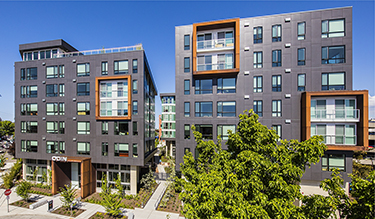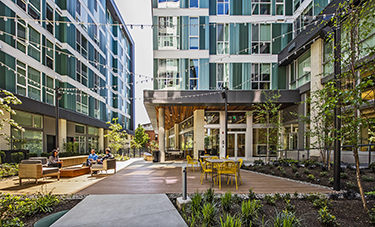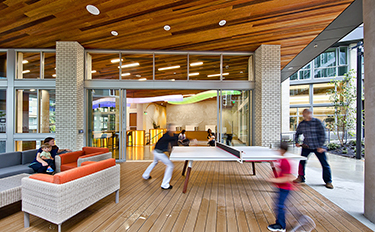|
Subscribe / Renew |
|
|
Contact Us |
|
| ► Subscribe to our Free Weekly Newsletter | |
| home | Welcome, sign in or click here to subscribe. | login |
Real Estate
| |
 |
June 23, 2016
Ballard’s Nordic roots come out at Odin Apartments
Runberg Architecture Group

Runberg
|

Flack
|
Urban cities are not static, nor should they be. They are constantly growing and changing to accommodate societal needs over time. Typically, change is incremental and, as a result, any disruption is more easily accommodated. Sometimes, it’s more sudden.
The sheer number of tower cranes in just the downtown core illustrates that Seattle is experiencing a period of intense change not seen for decades, if ever before. To that end, according to Rider Levett Bucknall, as reported in the DJC, there are currently some 60 fixed cranes in Seattle, up 43 percent over last summer.
This rapid growth is healthy, as it stimulates our economic engine and creates vitality and diversity in our cities. But this type of change also requires that design teams be sensitive to preserving pertinent neighborhood characteristics and identity.
Today’s successful architects look to address many of these key issues by asking themselves: What is it that makes an individual neighborhood special and interesting to begin with? What are the intrinsic aspects to cultivate to improve upon its individual identity? Was there something significant that occurred there in the past that we can learn from? Does it represent something significant about our society? And, does it function in a distinctive way?
These are just a few of the many potential influences that ultimately define a distinctive neighborhood in the midst of change. Above all, proper acknowledgment that these urban areas have unique characteristics to be embraced and honored — not eroded — represents a fundamental step toward appropriate and thoughtful redevelopment.
Ballard’s rich history
Such was the objective of our team when we started design on the Odin Apartments in Ballard for Equity Residential.
Rich in Scandinavian heritage and a central part of Seattle’s maritime and timber history, Ballard is one of the most culturally distinctive neighborhoods on the West Coast, and one that is transforming quickly before our eyes, especially during the most recent development cycle. The unique waterside working neighborhood is now a designated urban village and, as a result, earmarked to accommodate a significant portion of Seattle’s growth.
Most design responses would typically be contextual, but some are more culturally dominated. Odin was one such project. With this historic and cultural context in mind, we designed this 303-unit apartment building with the specific intent to enrich this resurgent neighborhood. Inside and out, we strove to bring to the project a unique experience of space.
Neighborhood character
Our approach to design at Odin, just like with any project, is closely linked to the building’s surrounding space. The blocks in this specific area of Ballard are unusually long, leaving little opportunity for pedestrians to meander through the neighborhood, as is part of the charm of the Old Ballard Avenue only a couple blocks away.
The Odin site is between Swedish Hospital, its four-story parking garage and All The Best Pet Care’s store parking lot — an awkward contrast in scale and character to the pedestrian-friendly older part of the neighborhood. Attempting to magically create an island of retail shops here was not viable. So, we carefully engaged the public realm through ground-level housing with stoops in some areas, and live-work units in others that ring the perimeter of the building.
In addition, there is no alley at Odin — no back side of the project at all. To enliven these frontage areas, individual canopies and signage, inspired by the scale and detail of the historic Ballard Avenue pedestrian environment, were brought into the design.
Further pedestrian scale was established by a desired mid-block connection; the building is organized around a central courtyard with a lush pedestrian mews that subtly migrates between the structures connecting the adjacent streets, much like the adjacent waterway that connects Puget Sound to Lake Union.
This form led to a “geode” metaphor, resulting in distinctive outer shell and inner courtyard elements. Scandinavian architects have often evoked design inspiration in their connection with nature through metaphors. Here, the geode split, or “fissure,” is positioned to maximize morning and afternoon sun streaming into the courtyard. A dramatic juxtaposition occurs between the enduring hard-edge exterior skin, contrasting with the delicate and translucent emerald green courtyard surfaces.
Marrying exterior and interior
The overall mass floats on a traditional Scandinavian white brick base in contrast with the translucent, green hues of the courtyard. Nordic sensibility is further translated through birch trees and expansive glass windows that allow the natural light to saturate the building interiors. Parallel to this, timber and maritime influences are woven throughout the material palate, from the exterior cladding down to the interior finishes.
For the interiors, Robin Chell Design embraced the strong Nordic vision and carried it beautifully throughout the building. Authentic Scandinavian touches ranged from subtle materials such as natural wood and exposed blackened steel, to more literal features such as an abstract wall covering inspired by a fishing lure, and the profile of a Viking ship etched into a concrete wall. The main lobby has a large, organic light fixture inspired by the movement, scale and tones of the Aurora Borealis, among other evocative features.
“We drew a lot of inspiration from both modern and classic elements of Scandinavian interior design,” explained Robin Chell. “Clean lines, open and airy spaces, and neutral tones balanced with pops of color give Odin a unique sense of place. It’s sophisticated and playful at the same time, paying homage to a classic interior style in an authentic yet unexpected way.”
The strength of continuity theme that runs throughout this project is greater than the sum of its parts. In an industry that is often driven by prescriptive methodology of development, and an industry that chases or repeats the latest trends, cultivating authenticity from deep within is a welcome departure.
When a design team steps into a new area, careful attention must be paid to the many nuances and characteristics that make that neighborhood a special place. Change is inevitable, but putting the right foot forward in a new development is a common responsibility to preserve character while accommodating the needs of future generations.
For Odin Apartments, Brian Runberg was the design principal and Larry Flack was the project architect. Runberg Architecture Group is a leading designer of sustainable urban mixed-use, housing and adaptive reuse projects.
Other Stories:
- In Pioneer Square, reality replaces myth
- High rise vs. low rise — which is greener?
- Seattle’s building boom pushes apartment evolution
- Look to the water for affordable housing
- For older apartments, choose renovation over demolition
- Capturing the past in today’s buildings
- Is dead retail space bringing your building down?
- New lease on life for iconic First Hill apartment
- Going beyond the mock-up with virtual reality
- Re-energizing an old power plant site on Lake Washington





